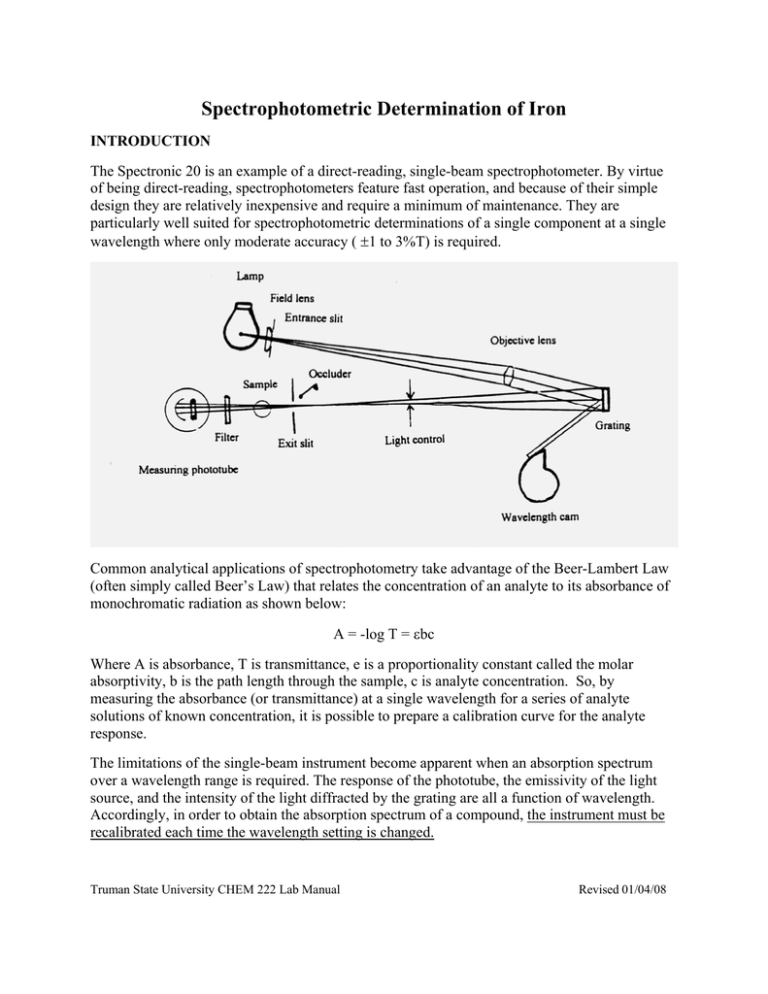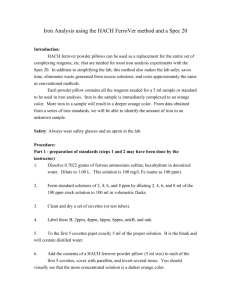Spectrophotometric Iron Determination Lab Manual
advertisement

Spectrophotometric Determination of Iron INTRODUCTION The Spectronic 20 is an example of a direct-reading, single-beam spectrophotometer. By virtue of being direct-reading, spectrophotometers feature fast operation, and because of their simple design they are relatively inexpensive and require a minimum of maintenance. They are particularly well suited for spectrophotometric determinations of a single component at a single wavelength where only moderate accuracy ( ±1 to 3%T) is required. Common analytical applications of spectrophotometry take advantage of the Beer-Lambert Law (often simply called Beer’s Law) that relates the concentration of an analyte to its absorbance of monochromatic radiation as shown below: A = -log T = εbc Where A is absorbance, T is transmittance, e is a proportionality constant called the molar absorptivity, b is the path length through the sample, c is analyte concentration. So, by measuring the absorbance (or transmittance) at a single wavelength for a series of analyte solutions of known concentration, it is possible to prepare a calibration curve for the analyte response. The limitations of the single-beam instrument become apparent when an absorption spectrum over a wavelength range is required. The response of the phototube, the emissivity of the light source, and the intensity of the light diffracted by the grating are all a function of wavelength. Accordingly, in order to obtain the absorption spectrum of a compound, the instrument must be recalibrated each time the wavelength setting is changed. Truman State University CHEM 222 Lab Manual Revised 01/04/08 HANDLING OF CUVETTES The handling of the cuvettes is extremely important. Often two cuvettes are used simultaneously, one for the "blank" solution and one for the samples to be measured. Yet any variation in the cuvette (such as a change in the cuvette width or curvature of the glass, stains, smudges, or scratches) will cause varying results. Thus, it is essential to follow several rules in dealing with cuvettes: 1. Do not handle the lower portion of a cuvette through which the light beam will pass. 2. Always rinse the cuvette with several portions of the solution before taking a measurement. 3. Wipe off any liquid drops or smudges on the lower half of the cuvette with a clean Kimwipe (or other lens paper) before placing the the cuvette in the instrument. Never wipe the cuvette with paper towels or handkerchiefs. Inspect the cuvette to ensure that nor bubbles are clinging to the inside walls. 4. When inserting a cuvette into the sample holder: a. To avoid any possible scratching of the cuvette in the optical path, insert the cuvette with the index line facing toward the front of the instrument. b. After the cuvette is seated, line up the index lines exactly. 5. When using two cuvettes simultaneously, use one of the cuvettes always for the blank solution and the other for the various samples being measured. Mark the cuvette ( on the upper portion) accordingly and do not interchange the cuvettes during the remainder of the experiment. 6. Do not use a test tube brush to clean the cuvettes after the experiment is complete. REAGENTS 1,10-phenanthroline (0.1 g of 1,10-phenanthroline monohydrate in 100 mL of distilled water, warming to effect solution if necessary). Hydroxylamine hydrochloride (10 g in 100 mL of distilled water). Sodium acetate (10 g in 100 mL of distilled water). Ferrous ammonium sulfate hexahydrate. PART A -- Determination of Spectral Response of a Single-Beam Spectrophotometer The purpose of this section is to familiarize you with the Spectronic 20 operation and to provide a justification for why you must reset your instrument response each time a new wavelength has Truman State University CHEM 222 Lab Manual Revised 01/04/08 been chosen The phototube in the Spectronic 20 is type S-4 (cesium-antimony). The relative response of the phototube to a beam of monochromatic light of constant intensity is greatest near 400 nm and decreases fairly rapidly above 475 nm. Its response at 625 nm is only 5% of that at its maximum near 400 nm. PROCEDURE The Spectronic 20 should be allowed to warm-up at least 10 minutes before use. First, adjust the instrument, photocell dark (i.e. no cuvette in the sample holder), with the zero control. Next, insert a cuvette filled with water into the sample holder. Rotate the 100% control until the meter needle reads near mid-scale. Now rotate the wavelength control in the range between 350 and 625 nm, adjusting the 100% control to allow the meter to stay on scale throughout the entire wavelength range. Note the wavelength where the transmittance is maximum (needle deflection is greatest). Carefully balance the instrument at 100% transmittance at the wavelength of maximum transmittance. You should now be able to rotate the wavelength control between 350 and 625 nm without the meter going off scale. Without changing either the dark current control or the 100%T control, vary the wavelength from 350 to 625 nm in 25 nm intervals and record the instrument response. Plot the instrument response vs. wavelength. PART B -- Determination of Iron with 1,10-phenanthroline INTRODUCTION The reaction between ferrous ion and 1,10-phenanthroline to form a red complex serves as a sensitive method for determining iron. Fe2+ + 3 phen → Fe(phen)32+ N N 1,10 – phenanthrolene (phen) The molar absorptivity of the complex, [(C12H8N2)3Fe]2+, is 11,100 at 508 nm. The intensity of the color is independent of pH in the range 2 to 9. The complex is very stable and the color intensity does not change appreciably over long periods of time. Beer's law is obeyed. The iron must be in the ferrous state, and hence a reducing agent is added before the color is developed. Hydroxylamine, as its hydrochloride, can be used to reduce any ferric ion that is Truman State University CHEM 222 Lab Manual Revised 01/04/08 present: 2 Fe3+ + 2 NH2OH + 2 OH- → 2 Fe2+ + N2 + 4 H2O The pH is adjusted to a value between 6 and 9 by addition of ammonia or sodium acetate. An excellent discussion of interferences and of applications of this method is given by Sandell.1 PROCEDURE 1. Weigh accurately about 0.07 g of pure ferrous ammonium sulfate hexahydrate, dissolve it in water, and transfer the solution to a 1-liter volumetric flask. Add 2.5 mL of concentrated sulfuric acid and dilute the solution to the mark. Calculate the concentration of the solution in mg of iron per mL. (Remember, your solution was prepared using Fe(NH4)2(SO4)2•6H2O). 2. Prepare the unknown sample as follows. Add about 0.12 g of the solid unknown and approximately 0.25 mL concentrated sulfuric acid into a 100 mL volumetric flask and dilute to the mark. Now transfer a 1 mL aliquot of this solution to another 100 mL volumetric flask - do not dilute yet. This will be referred to as the "prepared unknown". 3. Into five 100 mL volumetric flasks, pipet (volumetrically) 1, 5, 10, 25, and 50 mL portions of the standard iron solution. Put 50 mL of distilled water into another flask to serve as the blank. To each flask, including the "prepared unknown", add 1 mL of the hydroxylamine solution, 10 mL of the 1,10 phenanthroline solution and 8 mL of the sodium acetate solution. Then dilute all the solutions to the 100 mL marks and allow them to stand for 10 minutes with occasional shaking of the flasks. 4. Using the blank as a reference and any one of the iron solutions prepared above, measure the absorbance at different wavelengths in the interval from 400 to 600 nm. (Note that it is necessary to re-adjust the 0% T and 100%T settings whenever the wavelength is changed). Take reading about 20 nm apart except in the region of maximum absorbance where intervals of 5 nm should be used. Plot the absorbance vs. wavelength and connect the points to from a smooth curve. Select the proper wavelength to use for the determination of iron with 1,10phenanthroline. 5. Also, calculate the molar absorption coefficient, ε, at the wavelength of maximum absorption (λmax) on the absorption curve (assume b = 1 cm). 6. Measure the absorbance of each of the standard solutions and the unknown at the selected wavelength. Plot the absorbance vs. the concentration of the standards. Note whether Beer's law is obeyed. Using the absorbance of the unknown solution calculate the % (w/w) iron in your original solid sample and its 95% confidence interval, remember to correct for dilutions. (1) E. B. Sandell, Colorimetric Determination of Traces of Metals, 3rd Ed. Interscience Publishers, Inc., New York, 1959. Truman State University CHEM 222 Lab Manual Revised 01/04/08



